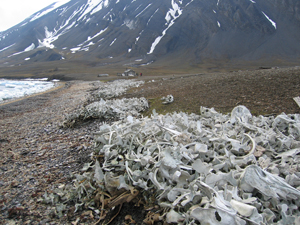 The white whale bones in Ingebrigtsenbukta testify to the slaughter that took place here. (Image: Stein Tronstad / The Norwegian Polar Institute)
The white whale bones in Ingebrigtsenbukta testify to the slaughter that took place here. (Image: Stein Tronstad / The Norwegian Polar Institute)
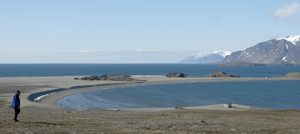 Fleur de Lyshamna is a sheltered bay at the entrance of Van Keulenfjorden. The picture is taken northwards; in the background you can see Eholmen, Midterhuken and Ingeborgfjellet (behind). Left in the picture you can make out the boats that were used to deploy the seine during the white whale hunt. (Image: Jørn Henriksen)
Fleur de Lyshamna is a sheltered bay at the entrance of Van Keulenfjorden. The picture is taken northwards; in the background you can see Eholmen, Midterhuken and Ingeborgfjellet (behind). Left in the picture you can make out the boats that were used to deploy the seine during the white whale hunt. (Image: Jørn Henriksen)
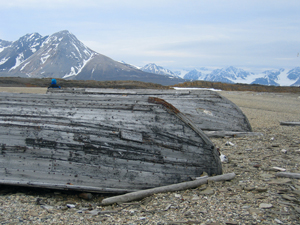 The boats at Ahlstrandodden. (Image: Stein Tronstad / The Norwegian Polar Institute)
The boats at Ahlstrandodden. (Image: Stein Tronstad / The Norwegian Polar Institute)
 Bamsebu is the only private cabin in Sør-Spitsbergen National Park. The cabin is in good repair. Outside the cabin stands a large whetstone that has seen better days. Left in the picture you can make out Kjeftausa – the upside-down rowboat used as storage. (Image: Jørn Henriksen)
Bamsebu is the only private cabin in Sør-Spitsbergen National Park. The cabin is in good repair. Outside the cabin stands a large whetstone that has seen better days. Left in the picture you can make out Kjeftausa – the upside-down rowboat used as storage. (Image: Jørn Henriksen)
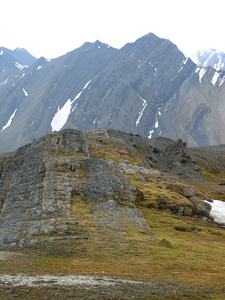 In Fleur de Lyshamna you can see large-scale geological formations of sandstone and clay slate.
In Fleur de Lyshamna you can see large-scale geological formations of sandstone and clay slate.
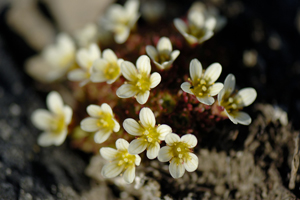 There is a large variety of saxifrage on the peninsula Ahlstrandhalvøya. This is drooping saxifrage (Saxifraga cernua). (Image: Jørn Henriksen)
There is a large variety of saxifrage on the peninsula Ahlstrandhalvøya. This is drooping saxifrage (Saxifraga cernua). (Image: Jørn Henriksen)
History
On the south side of Bellsund, where the beautiful Recherchefjorden turns east and enters Van Keulenfjorden, Ahlstrandodden is located. The headland is also called Kvitfiskneset, a name recalling white whales and the hunting of this species in the area. Along headlands, beaches and bays, all the way to Bamsebu in Ingebrigtsenbukta, are remains from the hunting of white whales in the 1930s.
The white whale is a small whale species. They travel in large groups (or pods), almost like schooling fish. In summer the white whales follow their prey into the fjords. Around Svalbard, polar cod is the main prey. The white whales were hunted for their blubber and skin. Like the earlier whaling of larger species, the meat was not used.
The hunt for white whales was summer-bound. To catch the whales they used large seine nets that were tied to land. These were transported out in the fjord with rowboats. When whales swam into the seine, the whalers closed the seine and rowed it back to shore, where the whales were shot or lanced. The boats were long, tall, wide and heavy and must have been strenuous to handle, especially with a seine full of belugas. Three pairs of oars were used to handle the boats and a roller for the seine was placed at the stern.
East of Ahlstrandodden there is a bay called Fleur de Lyshamna. The name is derived from the vessel of Prince Henry of Bourbon that mapped the area in the late 1800s. On the beach there are three old, grey seine boats that once belonged to Ingvald Svendsen from Tromsø, who was active in the white whale hunt in the interwar years. The boats are in relatively good condition. The boats are connected to Bamsebu – the whaling station that Svendsen built (see the next section about Bamsebu).
There are two cabins in Fleur de Lyshamna. One belongs to the Governor of Svalbard; it was moved there from Kapp Borthen in 2006. The other is of unknown origin and has been used by Russian archaeologists.
Kjeftausa/Bamsebu and the white whale hunt in Svalbard
The most striking thing when you approach Bamsebu by boat is the long white stripe of white whale bones on the beach. The bones tell the story of what happened on this beach: large-scale slaughtering. The amount of bones found here today indicate that about 550 whales were slaughtered here. The hunt must have been successful.
Around 1930 Ingvald Svendsen established a station in Ingebrigtsenbukta, which is now referred to as Bamsebu. The station was built solely for the purpose of white whale hunting, and is the only remaining example of such a station in Svalbard. The building could have originally been one of the Northern Exploration Company’s buildings, relocated from the eastern side of Recherchefjorden. In any case, Svendsen erected the building just above the beach in Ingebrigtsenbukta and turned it into a whaling station. The station consists of the main building that served as living quarters, two small shacks, three boats on the beach and some equipment and hunting equipment, not to mention all the bones. Apart from the bones, the building called Kjeftausa is the most striking part of the station. It is an upturned rowboat with a peat embankment just south-east of Bamsebu. It was probably used as food storage, but today the building is a monument to resourcefulness and re-use.
The white whale station at Ingebrigtsenbukta is unique in Svalbard and a vulnerable part of the islands’ cultural heritage. It has a significant archaeological value even if the hunt never turned into a large-scale industry. The bones and the boats on the beach tell of optimism and belief in the future through the exploitation of Svalbard’s natural resources.
Vulnerable elements
It is tempting to lift the bones to take a closer look, which would degrade and change these important cultural remains. Be careful while landing and anchoring small boats in Ingebrigtsenbukta and make sure you do not trample the bone piles.
Landing sites
In Ingebrigtsenbukta the best landing is on the beach between the bones and the cabin. Larger vessels can find good anchorage east of Kapp Toscana, smaller boats can enter Bourbonhamna and anchor and land there. Further west, in Malbukta there are also possible anchorages. From there you can land in Malbukta and hike across to Fleur de Lyshamna.
Recommended trails
It is easy to combine a visit to Bamsebu/Ingebrigtsenbukta and Fleur de Lyshamna, by hiking across the tundra. Make sure you have enough time – there is lots of interesting flora and geology along the 4 km route. You can choose if you want to hike along the beach or further in, on the strand terrace. Be aware that the tundra is wetter closer to the mountains. If you follow the coastline all the way, the distance is more than 4 km.